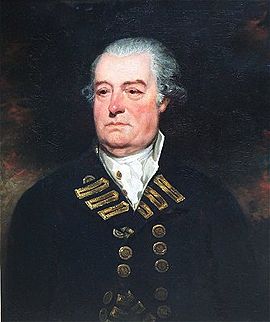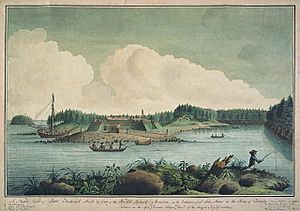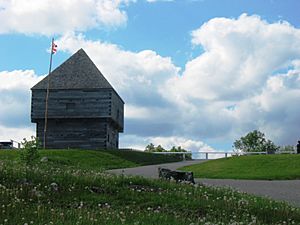St. John River expedition facts for kids
Quick facts for kids St. John River expedition |
|||||||
|---|---|---|---|---|---|---|---|
| Part of the American Revolutionary War | |||||||
 Admiral Mariot Arbuthnot, Lieutenant Governor of Nova Scotia - sent troops to end John Allan's operations |
|||||||
|
|||||||
| Belligerents | |||||||
| Commanders and leaders | |||||||
| John Allan | Gilfred Studholme Michael Francklin |
||||||
| Strength | |||||||
| about 100 militia | 120 troops | ||||||
| Casualties and losses | |||||||
| 12 killed | 1 killed | ||||||
The St. John River expedition was a military mission during the American Revolutionary War. It happened in 1777. A small group of American volunteer soldiers, called militia, led by John Allan, tried to bring the war to Nova Scotia.
Allan's group had about 100 volunteer soldiers and Indigenous people. They had little help from Massachusetts. In June 1777, they took over a small town. This town was at the mouth of the Saint John River. Today, this place is Saint John, New Brunswick. Back then, it was part of Nova Scotia.
The town's defenses were weak because of the war. The Americans quickly took control. They captured people who supported the British. About a month later, British forces arrived. They were led by Brigade Major Studholme and Colonel Francklin. The British successfully pushed the Americans away. Allan had to make a hard journey back to Machias, Maine by land. This was the last major American attack on Nova Scotia during the war. Nova Scotia stayed loyal to Britain.
Contents
Why the Expedition Happened

In 1776, the American Revolutionary War began. There was a small British town at the mouth of the Saint John River. This is where the city of Saint John, New Brunswick is now. This area was part of Nova Scotia. A small group of soldiers at Fort Frederick protected it.
When the war started, these soldiers left for Boston. An American militia from Machias, Massachusetts (now in Maine) attacked. They burned Fort Frederick. Later in 1776, Jonathan Eddy gathered a mixed group. It included Indigenous people, Massachusetts Patriots, and Nova Scotian supporters. They tried to capture Fort Cumberland. This fort protected the land route to Halifax. But they were not successful.
Pirate ships, called privateers, also became active. They attacked Nova Scotian ships and towns. By the end of 1776, Americans had captured almost 350 ships. They also raided towns like Yarmouth, Digby, and Cornwallis.
In early 1777, John Allan was given permission. He was a Nova Scotian living outside the area. The Second Continental Congress told him to plan a mission. He was to set up an American presence in western Nova Scotia. This area is now New Brunswick. Congress said he could recruit up to 3,000 men. But the Massachusetts government only gave him a colonel's rank. They let him raise a group of soldiers in eastern Massachusetts. His goal was to set up a base in the Saint John River valley. He wanted to get local Maliseet people and European settlers to join the American side. He hoped to gather enough soldiers to attack Fort Cumberland again.
The Expedition Begins
Colonel Allan left Machias on May 30, 1777. He had 43 men, including Indigenous people. They traveled in four whale boats and four birch canoes. More than half of Allan's men had fought with Eddy at Fort Cumberland. By June 2, Allan had 13 more canoes. He went east along the coast to Mechogonish (Duck Cove). This was west of the Saint John River's mouth.
Allan found no ships or soldiers at the Saint John's mouth. He sent 16 men led by Captain West. They walked about 3 miles (4.8 km) through the woods. They crossed the river above the Reversing Falls in canoes. Then they went to Portland Point. There, they surprised and captured James Simonds and William Hazen. These men were important founders of the Saint John settlement.
Colonel Allan and his group stayed for about a month. They were recruiting Maliseet Indigenous people. Allan mostly talked with them at their camp called Aukpaque. This was upriver from today's Fredericton, New Brunswick. Allan placed most of his men, about 60, at the mouth of the Saint John. Captains Dyer and West were in charge of them.
British Response and Retreat
Allan wanted to set up a lasting base. But British leaders in Halifax found out about his plan. A Loyalist, someone loyal to Britain, escaped Allan's men and told them. The Lieutenant Governor of Nova Scotia, Admiral Marriott Arbuthnot, sent British warships.
On June 23, the British warship HMS Vulture arrived. Brigade Major Gilfred Studholme and Colonel Michael Francklin were in command. A few days later, two more frigates, Milford and Ambuscade, joined. They had many soldiers from the Royal Fencible American Regiment and the 84th Regiment of Foot (Royal Highland Emigrants).
On June 30, about 120 men left the ships in barges. They landed at Mahogany Bay. This is now Manawagonish Cove, southwest of Saint John. They marched about 2.5 miles (4 km) towards the falls. They had a short fight with Allan's men near Fairville. In this brief battle, twelve Americans were killed. One British soldier from the 84th regiment also died. The Americans quickly went up the river. Dyer, West, and Allan returned to Machias. They traveled by way of the Oromocto and Magaguadavic rivers.
What Happened Next
Colonel Allan worked hard to get the friendship of the Indigenous people. He spent four weeks at Aukpaque. His efforts were somewhat successful. Many Maliseet people left the area to join the American forces in Machias. On July 13, 1777, a large group left the Old Fort Meduetic. It was about 8 miles (13 km) below Woodstock. Between 400 and 500 men, women, and children traveled in 128 canoes to Machias.
This group arrived at a very good time for the Americans. They helped a lot in defending Machias. This was during an attack by Sir George Collier from August 13 to 15. The British caused only minor damage to the place. The Indigenous people's help earned them thanks from the Massachusetts council.
After Allan's expedition, British settlers on the Saint John asked for better protection. Major Studholme was sent to provide a lasting military presence. This stopped plans by raiders from Machias to steal more from the Saint John settlement. Fort Howe was built under Studholme's direction in late 1777. The fort protected Saint John for the rest of the war. After the war, the area became a major home for United Empire Loyalists. These were people loyal to Britain who left the United States. William Hazen and his partners worked to keep the local Indigenous people loyal to the British.
Nova Scotia was not invaded by land again. But privateers continued to raid throughout the war. Later raids on Nova Scotia happened at Liverpool and Lunenburg. Naval battles also took place off the coast of Nova Scotia. These included a battle off Halifax and another off present-day Sydney.
See also


